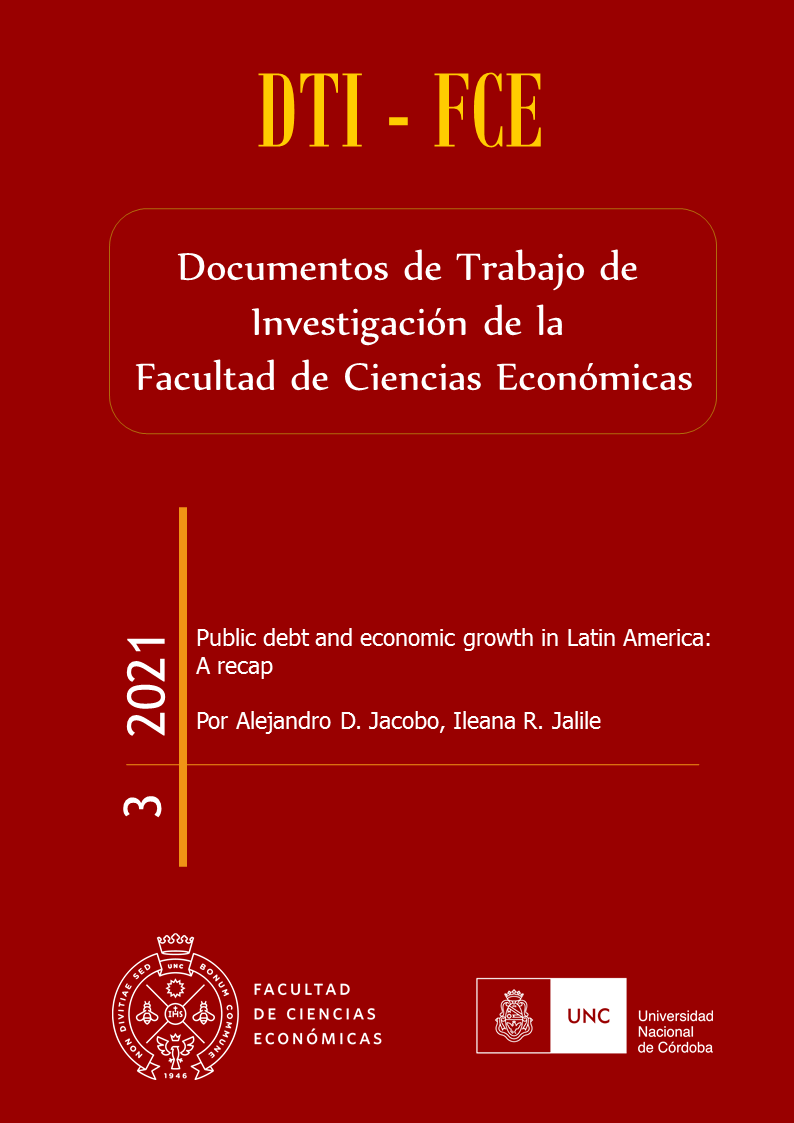Public debt and economic growth in Latin America: A recap
Palabras clave:
Debt, GrowthResumen
In this paper, we examine the effect of public debt on Gross Domestic Product (GDP) in 15 Latin American economies for fifty years. The short-run impact of debt on GDP growth is positive, but it is closer to zero beyond public debt-to-GDP ratios between 64 and 71% (i.e. up to this threshold, additional debt has a stimulating impact on growth). In the long-run, the threshold is between 95% and 97%.
Descargas
Referencias
Acemoglu, A. & Zilibotti, F. (1997). Was Prometheus Unbound by Chance? Risk, Diversification, and Growth. Journal of Political Economy, 105(4), 709-51.
Aghion, P., Alesina, A., & Trebbi, F. (2008). Electoral Rules and Minority Representation in U.S. Cities. Quarterly Journal of Economics, 123(1), 325-357.
Aghion, P. & Kharroubi, E. (2007). Cyclical Budgetary Policy and Economic Growth: What Do We Learn from OECD Panel Data? NBER Macroeconomics Annual, 22, 251-278.
Antonakakis, N. (2014). Sovereign debt and economic growth revisited: The role of (non) sustainable debt thresholds. Departamento de Economía, Universidad de Vienna. Retrieved from: http://epub.wu.ac.at/4321/.
Baldacci, E. & Kumar, M. (2010). Fiscal Deficits, Public Debt, and Sovereign Bond Yields. IMF Working Paper. 10/184. Retrieved from:
Baum, A., Checherita-Westphal, C. & Rother, P. (2013). Debt and Growth: New Evidence for the Euro Area. Journal of International Money and Finance, 32(C), 809-821.
Berg, A. & Ostry, J. (2011). Inequality and unsustainable growth: Two sides of the same coin. IMF Staff Discussion Note. 11/08. Retrieved from:
https://www.imf.org/external/pubs/ft/sdn/2011/sdn1108.pdf.
Calderón, C. & Fuentes, J. (2013). “Government Debt and Economic Growth”, IADB Working Paper 424. Retrieved from:
http://services.iadb.org/wmsfiles/products/Publications/38172661.pdf.
Caner, M., Grennes, T. & Koehler-Geib, F. (2010). Finding the Tipping Point- When Sovereign Debt Turns Bad. World Bank Policy Research Working Paper. 5391. Retrieved from: http://documents.worldbank.org/curated/en/509771468337915456/Finding-the-tipping-point-when-sovereign-debt-turns-bad.
Cecchetti, S., Mohanty, M. & Zampolli, F. (2011). The Real Effects of Debt. BIS Working Paper. 352. Retrieved from: https://www.bis.org/publ/work352.htm.
Chang, R., Kaltani, L. & Loayza, N. (2009). Openness is Good for Growth: The Role of Policy Complementarities. Journal of Development Economics, 90(1), 33-49.
Checherita-Westphal, C. & Rother, P. (2012). The impact of high government debt on economic growth and its channels: An empirical investigation for the euro area. European Economic Review, 56(7), 1392-1405.
Cochrane, J. (2011). Understanding policy in the Great Recession: Some unpleasant fiscal arithmetic. European Economic Review, 55(1), 2-30.
Diaz-Alejandro, C. (1965) Exchange Rate Devaluation in a Semi-Industrialized Economy: The Experience of Argentina 1955-61. Cambridge, Mass.: MIT Press.
Dollar, D. & Kraay, A. (2003). Institutions, trade, and growth. Journal of Monetary Economics, 50(1), 133-162.
Dreger, C. & Reimers, H. (2013). Does Euro Area Membership Affect the Relationship Between GDP Growth and Public Debt? Journal of Macroeconomics, 37(B), 481-486.
Easterly, W. & Levine, R. (2001). What have we learned from a decade of empirical research on growth? It’s Not Factor Accumulation: Stylized Facts and Growth Models. World Bank Economic Review, 15(2), 177-219.
Easterly, W. & Kraay, A. (2000). Small States, Small Problems? Income, Growth, and Volatility in Small States. World Development, 28(11), 2013-2027.
Eberhardt, M. & Presbitero, A. (2015). Public Debt and Growth: Heterogeneity and non- linearity. Journal of International Economics, 97(1), 45-58.
Edwards, S. (1985). Are Devaluations Contractionary? NBER Working Paper. 1676. Retrieved from: http://www.nber.org/papers/w1676.
Égert, B. (2015). The 90% Public Debt Threshold: The Rise and Fall of a Stylized Fact. Applied Economics, 47(34-35), 3756-3770.
Elmeskov, J. & Sutherland, D. (2012). Post-Crisis Debt Overhang: Growth and Implications across Countries. OECD Economics Department. Retrieved from: http://www.oecd.org/dataoecd/7/2/49541000.pdf.
Elmendorf, D. & N. Mankiw (1999). Government Debt. NBER Working Paper. 6470. Retrieved from: http://www.nber.org/papers/w6470.
Hiebert, P., Lamo, A., de Avila, D. & Vidal, J-P. (2002). Fiscal Policies and Economic Growth in Europe: An Empirical Analysis. Retrieved from:
Hole, R. (2007). A Comparison of Approaches to Estimating Confidence Intervals for Willingness to Pay Measures. Health Economics, 16(8), 827-840.
Jacobo, A. & Jalile, I. (2017). “The Impact of Government Debt of Economic Growth: An Overview for Latin America”, Quaderni del Dipartimento di Economia, Finanza e Statistica 28/2017, Università di Perugia, Dipartimento Economia. Retrieved from: https://www.econ.unipg.it/files/generale/wp_2017/wp_28_2017_jacobo_jalile.pdf
Krugman, P. (1994). The Myth of Asia Miracle. Foreign Affairs, 73(6), 62-78.
Krugman, P. & Taylor, L. (1978). Contractionary Effects of Devaluation. Journal of International Economics, 8(3), 1445-1456.
Kumar, M. & Woo, J. (2010). Public Debt and Growth. IMF Working Paper. 02/69. Retrieved from: https://www.imf.org/external/pubs/ft/wp/2010/wp10174.pdf.
Loayza, N, Fajnzylber, P. & Calderón, C. (2005). Economic Growth in Latin America and the Caribbean: Stylized Facts, Explanations, and Forecasts. Washington, DC: World Bank. Retrieved from: http://documents.worldbank.org/curated/en/647081468044960784/Economic-growth-in-Latin-America-and-the-Caribbean-stylized-facts-explanations-and-forecasts.
Munck, G. & Verkuilen, J. (2002). Conceptualizing and Measuring Democracy. Evaluating Alternative Indices. Comparative Political Studies, 35(1), 5-34.
North, D. (1990). Institutions, Institutional Change and Economic Performance. Cambridge: Cambridge University Press.
Panizza, H. & Presbitero, A. (2013). Public Debt and Economic Growth in Advanced Economies: A Survey. Swiss Journal of Economics and Statistics, 149(2), 175-204.
Reinhart, C. & Rogoff, K. (2010). Growth in a Time of Debt. American Economic Review, 100(2), 573-578.
Rodrik, D. & Rodriguez, F. (2001). Trade Policy and Economic Growth: A Skeptics Guide to the Cross-National Evidence, in B. Bernanke and K. Rogoff (editors), NBER Macroeconomics Annual 2000, 15, 261-325.
Schclarek, A. (2005). Debt and Economic Growth in Developing Industrial Countries”, Department of Economics, Lund University. Working Paper. 34. Retrieved from: https://project.nek.lu.se/publications/workpap/Pape/WP05_34.pdf.
Summerhill, W. (2015). Inglorious Revolution: Political Institutions, Sovereign Debt, and Financial Development in Imperial Brazil. New Haven: Yale University Press.
Teles, V. & Mussolini, C. (2014). Public debt and the limits of fiscal policy to increase economic growth. European Economic Review, 66(C), 1-15.
Vance, C. (2006). Marginal Effects and Significance Testing with Heckman’s Sample Selection Model: A Methodological Note. RWI Essen Discussion Papers. 39. Retrieved from: https://www.econstor.eu/bitstream/10419/1859/1/DP_06_039.pdf.
Winters, L. (2004). Trade liberalization and economic performance: An overview. Economic Journal, 114(493), F4-F21.
Yanikkaya, H. (2003). “Trade openness and economic growth: a cross-country empirical investigation”, Journal of Development Economics, 72(1), 57-89.
Archivos adicionales
Publicado
Número
Sección
Licencia
Derechos de autor 2021 Documentos de Trabajo de Investigación de la Facultad de Ciencias Económicas (DTI-FCE)

Esta obra está bajo una licencia internacional Creative Commons Atribución-NoComercial-SinDerivadas 4.0.






